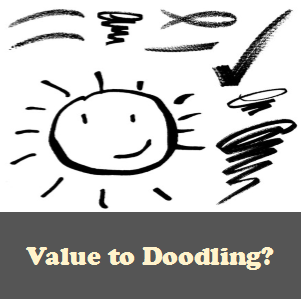I have a confession. I’m the student in the classroom that the teacher was always berating for not paying attention. A litany of pleas came my direction. “Tracy, put your pencil down.” “Tracy, are you listening?” “Stop scribbling on the edge of your paper.” “Pay attention.” “Eyes up front not on your drawings.” 
By the time I was in middle school, I felt like I was the evil student who didn’t know how to obey. Later, my mother told me about how she was hounded because she was left handed. She even had a ruler repeatedly smacked across her tiny hands when she was a small child learning how to write. I understood what she was saying, even if I didn’t have a ruler slapped across my knuckles. I cannot count the number of times I had my pencil taken away from me.
As an adult, I still doodle despite giving up this habit as a young student. I always have a notebook nearby -whether I am watching TV, reading a book, sitting in church, riding in a car — and the list can go on. But can doodling aid in learning?
Can doodling really aid learning?
As an adult (and armed with the ability to research on my own), I sought out to learn more about doodling. With notebook at my side as my ever-present guide, if not crutch, I walked through my public library while my son worked on a school project. Nothing. Many wonderful books on art. I perused them but didn’t find what I was looking for. (I am sure the librarians intentionally kept doodling out of the library -belonging to some old age code of how to really learn.)
The internet provided the best resource. I read article after article which reaffirmed what I knew instinctively. Doodling does help learning! It helps me. When I doodle and add graphics to my writings, I’m able to quickly locate what I want at a later date. And why not? After all, didn’t Da Vinci do the same thing? Okay — maybe that is a stretch. One cannot really claim that his drawings are doodles.
Benefits of Doodling
Sue Shallenbarger (2014) wrote a beautiful article about how doodling not only aids in learning but may actually promote it! Doodling has benefits.
- Doodling aids in relieving tension.
- It appeals and helps the visual learner retain information.
- It helps to process information.
- Doodling will act as a catalyst for problem solving.
- Scaffolding ideas and creating connections between old information and new knowledge is another added benefit. (Remember — this is why educators use graphic organizers.)
- Doodling creates a dialog between the hand and the mind.
- It improves both memory and focus.

There is even research which proves the importance of doodling to help students pay attention! And guess what? There are books which teach how to doodle! Plus, my personal favorite, a book by Sunni Brown, claiming that the doodle is a revolution!
And think … if only I were a elementary school aged student in this day and age, maybe my teachers would proudly display my doodles as a beautiful addition to learning!
Interested in learning the basics of doodling? Here is a link to a free course:
Doodle Course
 Subscribe to our YouTube Channel by clicking here.
Subscribe to our YouTube Channel by clicking here.
Sources:
Cloud, J. (2009). Study: Doodling Helps You Pay Attention. Retrieved from http://content.time.com/time/health/article/0,8599,1882127,00.html
Shallenbarger, S. (2014). The Power of the Doodle. Retrieved from http://www.wsj.com/articles/the-power-of-the-doodle-improve-your-focus-and-memory-1406675744
![]() Subscribe to our YouTube Channel by clicking here.
Subscribe to our YouTube Channel by clicking here.
By Tracy Atkinson
 Tracy Atkinson, mother of six, lives in the Midwest with her husband and spirited long-haired miniature dachshunds. She is a teacher, having taught elementary school to higher education, holding degrees in elementary education and a master’s in higher education. Her passion is researching, studying and investigating the attributes related to self-directed learners. She has published several titles, including The Art of Learning Journals, Calais: The Annals of the Hidden, Lemosa: The Annals of the Hidden, Book Two, Rachel’s 8 and Securing Your Tent. She is currently working on a non-fiction text exploring the attributes of self-directed learners: The Five Characteristics of Self-directed Learners.
Tracy Atkinson, mother of six, lives in the Midwest with her husband and spirited long-haired miniature dachshunds. She is a teacher, having taught elementary school to higher education, holding degrees in elementary education and a master’s in higher education. Her passion is researching, studying and investigating the attributes related to self-directed learners. She has published several titles, including The Art of Learning Journals, Calais: The Annals of the Hidden, Lemosa: The Annals of the Hidden, Book Two, Rachel’s 8 and Securing Your Tent. She is currently working on a non-fiction text exploring the attributes of self-directed learners: The Five Characteristics of Self-directed Learners.

Comments are closed